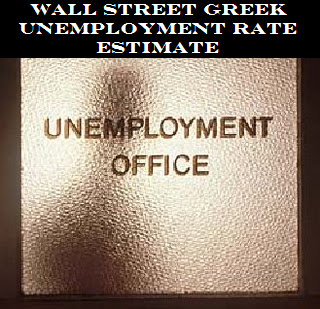 The week offered two labor market data points, including the monthly state employment data and the regular weekly initial jobless claims report. My take from the data is that the labor market sits in dead-tide now, and we should look toward Texas for the rising tide.
The week offered two labor market data points, including the monthly state employment data and the regular weekly initial jobless claims report. My take from the data is that the labor market sits in dead-tide now, and we should look toward Texas for the rising tide.  Our founder earned clients a 23% average annual return over five years as a stock analyst on Wall Street. "The Greek" has written for institutional newsletters, Businessweek, Real Money, Seeking Alpha and others, while also appearing across TV and radio. While writing for Wall Street Greek, Mr. Kaminis presciently warned of the financial crisis.
Our founder earned clients a 23% average annual return over five years as a stock analyst on Wall Street. "The Greek" has written for institutional newsletters, Businessweek, Real Money, Seeking Alpha and others, while also appearing across TV and radio. While writing for Wall Street Greek, Mr. Kaminis presciently warned of the financial crisis.Relative Tickers: NYSE: RHI, NYSE: KFY, NYSE: MAN, NYSE: MWW, Nasdaq: KELYA, Nasdaq: JOBS, NYSE: JOB, Nasdaq: CECO, Nasdaq: PAYX, NYSE: ASF, Nasdaq: KFRC, NYSE: TBI, NYSE: DHX, NYSE: SFN, NYSE: CDI, Nasdaq: CCRN, Nasdaq: ASGN, NYSE: AHS, Nasdaq: BBSI, Nasdaq: HHGP, NYSE: SRT, Nasdaq: RCMT, Nasdaq: VSCP, OTC: ASRG.OB, OTC: MCTH.OB, OTC: IGEN.OB, OTC: STJO.OB, OTC: TNUS.OB, Nasdaq: TSTF, OTC: STTH.OB, OTC: PSRU.OB, OTC: CRRS.OB, NYSE: BAC, NYSE: JPM, NYSE: GS, NYSE: C, NYSE: MS, NYSE: WFC, NYSE: TD, NYSE: PNC, NYSE: GE, NYSE: WMT, NYSE: MCD, NYSE: AA, NYSE: AXP, NYSE: BA, NYSE: CAT, Nasdaq: CSCO, NYSE: CVX, NYSE: DD, NYSE: DIS, NYSE: HD, NYSE: HPQ, NYSE: IBM, Nasdaq: INTC, NYSE: JNJ, NYSE: KFT, NYSE: KO, NYSE: MMM, NYSE: MRK, Nasdaq: MSFT, NYSE: PFE, NYSE: PG, NYSE: T, NYSE: TRV, NYSE: UTX, NYSE: VZ, NYSE: XOM, NYSE: DE, NYSE: TIF, NYSE: CO, NYSE: FRO, NYSE: DIA, NYSE: SPY, Nasdaq: QQQQ, NYSE: DOG, NYSE: SDS, NYSE: QLD, NYSE: NYX, NYSE: ICE, Nasdaq: NDAQ.
Job Market Recap - Texas Offers Guidance
The latest tally of initial unemployment claims, covering the week ending June 11, produced a modest improvement in the weekly count. New benefits filers numbered 414K, but that was 16K less than the week before. The four-week moving average, however, was unchanged at 424,750. Thus, the report was a non-starter for stocks this past week, and took a back seat to the flood of fear from Greece.
The insured unemployment rate, which measures just the folks collecting regular unemployment and not the massive list of Americans collecting on the unemployment insurance extension legislation, stuck at 2.9% through the June 4 period. That said, the count still fell by 21K, to 3,675,000. What matters more though is that when including those receiving benefits from all programs, including the extension legislation, the number of check recipients reached 7,401,228 in the week ending May 28. Good news though; that’s down 209K from the previous week. Despite all that good news for May, we already know the unemployment rate rose 9.1% last month, so this week’s data was delivered with doubt.
The weekly report of course always offers the latest state data showing the states with the biggest increases in unemployment and those states with the highest rates of joblessness. The highest insured unemployment rates in the week ending May 28 were in Alaska (4.9 percent), Puerto Rico (4.5), Oregon (4.1), Pennsylvania (3.9), Nevada (3.5), New Jersey (3.5), Virgin Islands (3.5), California (3.4), Connecticut (3.4), Arkansas (3.2), Idaho (3.2), Illinois (3.2), and Mississippi (3.2).
The largest increases in initial claims for the week ending June 4 were in Wisconsin (+1,528), Tennessee (+1,055), Illinois (+755), New Mexico (+659), Indiana (+539), while the largest decreases were in New York (-4,060), California (-2,510), Massachusetts (-1,846), Georgia (-1,256), and Florida (-1,240).
Speaking of states, this past week offered state data for the full month of May, and it showed more states experienced an increase in unemployment (24) than saw decreases (13 plus the District of Columbia). Another 13 states reported no change in employment. Of course, this data was consistent with what we already know about May on a national scale.
There was a surprise of sorts though found in the state-level nonfarm payroll data. The report showed that nonfarm payroll decreased in more states than it increased in, which was inconsistent with the total nonfarm payroll rise of 54K. We would suppose some of the less populated states fell into the short side of the count, with more crowded states adding jobs. What we found was something else though.
Regurgitating the state details for you: The greatest contributors to new employment were Florida (+28,000), followed by Ohio (+12,000), Arizona and Louisiana (+10,100 each), and Texas (+8,800). As far changes to the rate of employment, which of course incorporates population size, this showed Wyoming experienced the largest monthly percentage increase in employment (+0.8 percent), followed by Louisiana (+0.5 percent) and Arizona and Florida (+0.4 percent each). The worst monthly decrease in employment occurred in California (-29,200), followed by New York (-24,700), Pennsylvania (-14,200), Michigan (-13,400), and Maryland (-13,300). This is not consistent with what we would have expected, as the national nonfarm payroll change was a positive result. Yet, here we have the busy states of New York and California shedding jobs. Alaska experienced the largest percentage decline in employment (-1.5 percent), followed by Vermont (-1.2 percent), Delaware (-0.9 percent), and West Virginia (-0.7 percent).
Over the course of the full year, we have states like Texas to thank for our national recovery. The largest nonfarm payroll increase occurred in Texas (+205,400), followed by California (+87,300), Ohio (+65,900), Illinois (+61,600), and Pennsylvania (+44,300). Nevada continued as the state with the highest unemployment rate in May, at 12.1%. However, Nevada also saw the greatest drop in unemployment over the course of the year, with a 2.8% change for the better. I suppose we could label Nevada a high-beta state, more dependent on the general economic health of the nation than any other state, with Florida or New York likely following in second. Las Vegas attracts Americans from far and wide, but only when discretionary capital exists and jobs are available.
The growth in Texas is impressive, a state incorporating several of the nation’s largest cities. The Texas economy has been so impressive that there’s talk of its Republican Governor, Rick Perry, running for President employing Texas-success as his rally call. California is at the polar opposite though, with unemployment not much changed and sitting at 11.7% through May. California’s yearly job creation of 87K is negligible when matched to the state’s massive population and number of new entrants to the workforce.
In conclusion, the week’s labor data offered little guidance, and given the economic deterioration seen in manufacturing and consumer measures last week, investor concern might lean toward labor market deterioration to follow. Perhaps America should look towards Texas for guidance, but certainly not to California...

Article should interest investors in Paychex (Nasdaq: PAYX), Manpower (NYSE: MAN), Robert Half International (NYSE: RHI), 51Job Inc. (Nasdaq: JOBS), Monster World Wide (NYSE: MWW), Korn/Ferry International (NYSE: KFY), Administaff (NYSE: ASF), Kforce (Nasdaq: KFRC), TrueBlue (NYSE: TBI), Dice Holdings (NYSE: DHX), Kelly Services (Nasdaq: KELYA), SFN Group (NYSE: SFN), CDI Corp. (NYSE: CDI), Cross Country Healthcare (Nasdaq: CCRN), On Assignment (Nasdaq: ASGN), AMN Healthcare Services (NYSE: AHS), Barrett Business Services (Nasdaq: BBSI), Hudson Highland Group (Nasdaq: HHGP), StarTek (NYSE: SRT), RCM Technologies (Nasdaq: RCMT), VirtualScopics (Nasdaq: VSCP), American Surgical (OTC: ASRG.OB), Medical Connections (OTC: MCTH.OB), iGen Networks (OTC: IGEN.OB), St. Joseph (OTC: STJO.OB), General Employment Enterprises (NYSE: JOB), Total Neutraceutical (OTC: TNUS.OB), TeamStaff (Nasdaq: TSTF), Stratum (OTC: STTH.OB), Purespectrum (OTC: PSRU.OB), Corporate Resource Services (OTC: CRRS.OB), Bank of America (NYSE: BAC), J.P. Morgan Chase (NYSE: JPM), Goldman Sachs (NYSE: GS), Citigroup (NYSE: C), Morgan Stanley (NYSE: MS), Wells Fargo (NYSE: WFC), TD Bank (NYSE: TD), PNC Bank (NYSE: PNC), General Electric (NYSE: GE), Wal-Mart (NYSE: WMT), McDonald's (NYSE: MCD), Alcoa (NYSE: AA), American Express (NYSE: AXP), Boeing (NYSE: BA), Caterpillar (NYSE: CAT), Cisco Systems (Nasdaq: CSCO), Chevron (NYSE: CVX), DuPont (NYSE: DD), Walt Disney (NYSE: DIS), Home Depot (NYSE: HD), Hewlett-Packard (NYSE: HPQ), IBM (NYSE: IBM), Intel (Nasdaq: INTC), Johnson & Johnson (NYSE: JNJ), Kraft (NYSE: KFT), Coca-Cola (NYSE: KO), 3M (NYSE: MMM), Merck (NYSE: MRK), Microsoft (Nasdaq: MSFT), Pfizer (NYSE: PFE), Procter & Gamble (NYSE: PG), AT&T (NYSE: T), Travelers (NYSE: TRV), United Technologies (NYSE: UTX), Verizon (NYSE: VZ), Exxon Mobil (NYSE: XOM).
Please see our disclosures at the Wall Street Greek website and author bio pages found there. This article and website in no way offers or represents financial or investment advice. Information is provided for entertainment purposes only.
Labels: Economic-Reports, Labor Market, Labor-Market










































